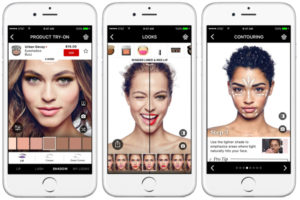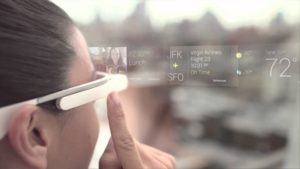Mindshare UK, in partnership with AR technology company Zappar, has launched ‘Layered’ – a report identifying how brands must adapt to the rise of augmented reality (AR).
• The report reveals that a third (33%) of consumers believe AR would help them to narrow down choices when shopping.
• Increasingly, consumers are expecting products and other physical objects to contain additional layers of digital content or information. In fact, 55% want to be able to point their phone at any object and receive information about it, rising to 74% amongst those who have already experienced AR.
• Working with Neuro-Insight, the study also reveals that AR experiences generate almost double (1.9 times) the levels of engagement amongst consumers compared to their non-AR equivalent.
• Consumers are already anticipating the potential of AR smart glasses. Over a quarter (26%) of consumers would prefer to experience AR hands-free through smart glasses than through their mobile phones.
Jeremy  Pounder, Futures Director at Mindshare UK, explains: “To date, AR has largely been used to give people a small dose of in-the-moment fun – Snap’s dancing hotdog and Pokémon Go epitomise this. Our research shows that AR will evolve from one-off ‘surprise and delight’ moments to provide everyday utility and practical value, right across the consumer journey. This could include helping people visualise how products look in their home, locating products in-store through wayfinding applications, or getting more out of a product post-purchase through usage guidance.”
Pounder, Futures Director at Mindshare UK, explains: “To date, AR has largely been used to give people a small dose of in-the-moment fun – Snap’s dancing hotdog and Pokémon Go epitomise this. Our research shows that AR will evolve from one-off ‘surprise and delight’ moments to provide everyday utility and practical value, right across the consumer journey. This could include helping people visualise how products look in their home, locating products in-store through wayfinding applications, or getting more out of a product post-purchase through usage guidance.”
Max Dawes, Marketing & Partnerships Director at Zappar, explains: “At Zappar we’ve been living and breathing AR for the past seven years, so we jumped at the opportunity to partner with Mindshare UK to reflect on what’s been and what’s on the way.
“As the AR landscape evolves and matures there’s one certainty, that’s the need for software to build experiences for this new canvas. These are of fundamental importance for brands and content developers to have the opportunity to tell stories, create genuinely worthwhile experiences and provide practical and engaging solutions within the consumer user-journey. We’re in a time where whole sectors, such as product packaging, are being reimagined as always on media channels.”
The Layered report identifies four trends that will shape how consumers embrace augmented reality:
Trend 1 – From ‘surprise and delight’, to everyday utility
Until now, AR applications have largely been used to give people a bite-sized dose of fun through face filters, games or playful print ad activations.
To  understand more fully the brain’s response to AR experiences, in partnership with Neuro-Insight we conducted the first neuroscience research experiment of its kind with over 150 respondents. The study revealed that AR experiences generate almost double (1.9 times) the levels of engagement compared to their non-AR equivalent. This capacity of AR to ‘surprise and delight’ will endure, as the boundaries of AR are continually pushed through innovation.
understand more fully the brain’s response to AR experiences, in partnership with Neuro-Insight we conducted the first neuroscience research experiment of its kind with over 150 respondents. The study revealed that AR experiences generate almost double (1.9 times) the levels of engagement compared to their non-AR equivalent. This capacity of AR to ‘surprise and delight’ will endure, as the boundaries of AR are continually pushed through innovation.
But there is untapped potential for AR to fulfil wider needs. Our respondents identified a range of currently unfulfilled areas where AR could provide everyday utility, including going to the gym, house buying, on-pack information and DIY tasks.
Brands need to continue to use AR to create immersive brand experiences that truly surprise and delight customers. But they also need to think about how they can help solve everyday problems in the consumer journey using AR.
Trend 2 – Layering
People will start to expect the physical surfaces around them to be embedded with additional layers of interactive content. Over half (55%) of respondents agreed that ‘it would be a good thing if you could point your phone at any object and get additional information’.
Brands should be thinking about adding extra layers of content to their owned assets. For example:
should be thinking about adding extra layers of content to their owned assets. For example:
• They can change a passive touchpoint with huge reach, such as product packaging into a fully immersive experience.
• If they already have an app with a substantial user base they can amplify the in-app experience through AR.
• For bricks and mortar retailers, the in-store environment provides a varied canvas for delivering engagement experiences or customer service through AR.
Trend 3 – Surfacing
AR will increasingly enable the proactive ‘surfacing’ of personalised, contextual content without the user initiating it. Over two-thirds (68%) of AR users believe AR would be most useful if it ‘can figure out the right information to show me at the right time all by itself’.
As part of our neuroscience experiment, we found that the part of the brain responsible for memory encoding sees almost three times (2.9 times) the level of activity when using AR versus carrying out the same task without AR. This indicates that AR may be a particularly powerful way to deliver information that is subsequently retained.
One  of the key drivers for content surfacing will be computer vision (machine learning-based image recognition) such as Google Lens. As this technology advances, cameras will be capable of ‘reading’ the environment and making decisions about what content to share with the user. AR glasses will allow the concept of content surfacing to fully develop.
of the key drivers for content surfacing will be computer vision (machine learning-based image recognition) such as Google Lens. As this technology advances, cameras will be capable of ‘reading’ the environment and making decisions about what content to share with the user. AR glasses will allow the concept of content surfacing to fully develop.
Brands will need to optimise their content for computer vision, ensuring that when Google Lens identifies their product, the content that is surfaced is the most relevant for the consumer.
Trend 4 – Flowing
As Artificial Intelligence ushers in an ‘age of assistance’ and helps life flow a little more smoothly, it is likely that AR (and AR ‘smart’ glasses) will become key tools.
In the next five to ten years we expect a new form of AR glasses to emerge which will enable an always-on scanning of the environment, identifying objects and overlaying related content. Already over 25% of people prefer AR  glasses over the mobile phone screen for wayfinding, ‘how-to’ and ‘try before you buy’ experiences. This preference is even stronger amongst people who have already experienced AR.
glasses over the mobile phone screen for wayfinding, ‘how-to’ and ‘try before you buy’ experiences. This preference is even stronger amongst people who have already experienced AR.
Irrespective of how quickly AR glasses develop, we expect AR to play a wider role in the consumer journey with 33% of respondents believing AR can help narrow down retail purchase decisions. While AR is currently mostly used for ‘evaluation’ or ‘post-purchase’ stages, there is great opportunity for it to facilitate direct purchase.
Source: Mindshare UK

You must be logged in to post a comment Login